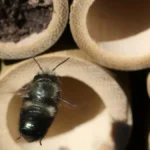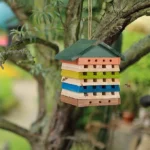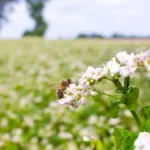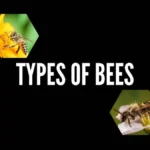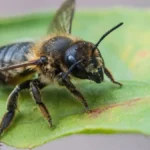The long horned bee, or should I say bees, are so-called because the males have very long antennae. These important pollinators are solitary bees and niche pollinators, often specializing in a very specific group of plant species that they pollinate. Let us have a closer look at these fascinating and important bees.
For many of us, a “bee” is a honeybee – our trusty friend Apis mellifera. There are however many other bees out there – in fact, many many thousands of species of bees out there. The vast majority are solitary species. Solitary bees are seasonal, emerging in spring and pollinating flowers through the growing season. The males mate with females and the females collect pollen and provision small nest sites where they lay eggs.
In previous articles, we had a look at bumblebees – these form colonies but in smaller numbers than honey bees. We also had a look at the solitary red mason bee. Both of these types of bees are excellent pollinators and are relatively generalist in terms of flower choices. Let us now have a look at the long-horned bees, which are more specialist pollinators.
The Long-horned Bee
There is in fact no single long-horned bee – there are many species in the genera Eucera and Melisoides and a scattering of other genera. Let us take a look at a few fun species we may find in North America.
Florilegus Condignus
This is a solitary bee with a size of about half an inch. There is a huge difference in appearance between males and females. The males have exceptionally long antennae (remember the longhorn name). Both males and females have green eyes, with the female being more blue-green. The eyes are beautiful.
This bee is often described as being a pollinator of very specific plants found on the banks of lakes – however, it is actually an important pollinator of Alfalfa. The Alfalfa(Lucern) plant is a very important animal feed plant and is both a pasture plant and a crop harvested for incorporation into feedlot rations and pellets.
Alfalfa Pollination
The pollination of Alfalfa is quite complicated – the flowers contain low-sugar nectar that is not very attractive to honeybees, but attractive to butterflies. Butterflies are lovely and pretty and all those good things – but they lay eggs. The eggs become caterpillars and these eat the leaves. If you are farming Alfalfa you do not really want the plants to be pollinated by butterflies.
The Florilegus condignus long-horned bee is however able to pollinate alfalfa. In so doing this bee increases the seed set on flowers resulting in higher protein content in the hay or pasture produced. To summarize – next time you enjoy an egg, or a nice bit of butter or cheese, or a steak, there is a very good chance that some of the protein in that is there because of a long-horned bee pollinating alfalfa flowers.
The Melissodes Bee
Melissodes Communis
The Common Long-horned bee, Melissodes communis, is widely disturbed in North America. More often than not, if somebody talks about “the long-horned bee” then it is this little fuzzball. These bees are fun to watch – I have spent hours watching these in Canada and the US and they are just awesome little bees.
Rather bizarrely, the Common Long-horned bee is acknowledged to be an important pollinator, but very little is known about it. This needs to change. Much of what is known is actually just an educated guess based on what closely related species do. So let us not fall into this trap, and rather say, we have no idea how or what the common Long-horned bee really does to reproduce and so on. Now let us take a look at its relative, Melissodes rustica, and find out what fascinating things this bee does.
Mellissodes Rustica
Mellissodes rustic appears to have had a little more research performed on it – although from what I can find most of this appears to be a few decades old like me. Quite a few. It would be lovely if we can study these insects a bit more before we accidentally wipe them out through lack of knowledge.
It appears that the females burrow and make underground nests in adobe-like soil. This nest is craftily constructed to minimize collapse. The nest is used for rearing young that are fed relatively dry pollen diets. I can find little data on the actual composition of the pollen feed.
It appears again that the majority of data as to what these bees pollinate is based on limited observation. With modern camera traps and data gathering technology, we can probably do a lot better in terms of finding out more, and this is a space where citizen science can help.
What You Can Do To Help Study Vanishing Bees
My father is a retired ichthyologist and his colleague, an entomologist has recently retired too. Both have dedicated their scientific experience to photography and documentation of creatures that are understudied in their retirement. Recent advances in Camera traps have opened up a new world that was not available in their paid careers.
As citizen scientists, we can rope in an army of photographers who can use new technologies to study what insects approach flowers and where. There are a number of off-the-shelf camera traps for larger wildlife – but my friend who is an Arduino tinkerer says it would be very easy to make a bespoke camera trap for bees if you know these systems. He suggested starting with this.

I hope this article has helped you understand a little more about the long-horned bees. These fascinating insects need us to focus on them and learn about them so we can conserve them and allow them to keep making our world a better place. Let us all network our skills and study these! If you feel inspired, please share.
Read more about: What Are Saskatraz Bees?
Long Horned Bee FAQs
1. What is a long-horned bee?
A long-horned bee is a type of solitary bee known for the males’ long antennae. These bees are important pollinators, specializing in specific plant species, including alfalfa.
2. How do long-horned bees differ from honeybees?
Unlike honeybees, long-horned bees are solitary and do not live in colonies. They also focus on pollinating specific plants, while honeybees are more generalist pollinators.
3. What plants do long-horned bees pollinate?
Long-horned bees often pollinate specific plants such as alfalfa. Their specialized pollination helps improve the quality and yield of crops like this.
4. Why are long-horned bees important for agriculture?
Long-horned bees play a crucial role in pollinating alfalfa, a key crop used for animal feed. Their pollination increases seed set, boosting the protein content in hay and pasture.
5. How can long-horned bees help with alfalfa pollination?
These bees are uniquely suited to pollinating alfalfa flowers, which are less attractive to honeybees. This makes them vital for increasing seed production and improving crop quality.
6. Where are long-horned bees found?
Long-horned bees can be found in various regions of North America. Different species thrive in distinct environments, such as near lakes or in adobe-like soil.
7. Are long-horned bees endangered?
Some species of long-horned bees may be at risk due to habitat loss and lack of research. It’s important to study them to prevent their decline.
8. How can I help protect long-horned bees?
You can help by participating in citizen science projects, using camera traps to monitor bee activity, and advocating for the protection of their natural habitats.
9. What is the common long-horned bee?
The common long-horned bee (Melissodes communis) is the most widely known species of this bee type. It’s commonly found across North America and is a vital pollinator.
10. How do long-horned bees make their nests?
Long-horned bees, like Melissodes rustica, make underground nests in adobe-like soil. The females create burrows where they lay eggs and provision their young with pollen.

Dr. Garth A. Cambray is a Canadian/South African entrepreneur and beekeeper with 28 years of experience in apiculture and specializes in adding value to honey. His Ph.D. research developed a new advanced continuous fermentation method for making mead that has resulted in a number of companies globally being able to access markets for mead. His company, Makana Meadery, exports honey mead to the USA where it is available to discerning connoisseurs. He has also developed technologies to commercially manufacture organic honey vinegar in Zambia for export globally. He holds a few patents globally in the ethanol industry and believes in technology and knowledge transfer for human development and environmental sustainability. One of his proudest achievements is the fact that the wind farm he started at one of his old apiary sites has essentially made his hometown carbon neutral.

